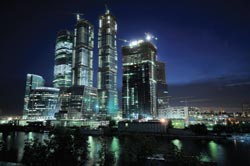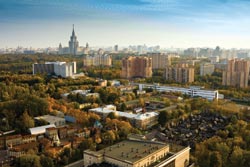The vast landscape of the Russian Federation is home to more than 800 laser-related organizations and companies spread over 85 cities in 57 regions. Along with other functions they perform, these laser entities train specialists, service laser equipment, carry out research and development, and produce various laser devices and completing parts, such as laser sources and optics.
The field of laser optics-related science and technology is one of the most highly developed sectors in the world of Russian high technology, according to Ivan B. Kovsh, president of the Laser Association, which is based in Moscow. The Laser Association unites laser research laboratories, companies, enterprises and universities in the territory of the former Soviet Union. Russian institutions and specialists account for more than 80 percent of its membership.
 Kovsh said that Russian laser companies offer about two thousand models of laser technology to the market – among them, laser sources, industrial and medical lasers, measuring and testing equipment, navigation and aligning systems, and devices for laser beam characterization, controlling, shaping and modulating. He added that there are 165 “producing” laser enterprises and institutions in Russia, 40 percent of which are located in the Moscow region, 15 percent in the St. Petersburg and Leningrad areas, 6 percent in Novosibirsk, and another active percentage in the Volga, Ural and Central Siberian (Tomsk) regions.
Kovsh said that Russian laser companies offer about two thousand models of laser technology to the market – among them, laser sources, industrial and medical lasers, measuring and testing equipment, navigation and aligning systems, and devices for laser beam characterization, controlling, shaping and modulating. He added that there are 165 “producing” laser enterprises and institutions in Russia, 40 percent of which are located in the Moscow region, 15 percent in the St. Petersburg and Leningrad areas, 6 percent in Novosibirsk, and another active percentage in the Volga, Ural and Central Siberian (Tomsk) regions.
There are six large-volume production optics plants in Russia as well as about 40 small optics businesses. The process of privatization is active, according to Kovsh, who added that about half of the organizations in the Russian laser optics industry are now privately owned, while the others remain state-owned.
Kovsh said that, in light of the uncertain status of the current global economy, a forecast for the photonics market in Russia would be difficult, if not impossible, to predict at this time.
Growth in fiber laser production
According to Kovsh, there is significant growth in industrial laser usage in Russia, and the number of units sold in 2007 was two times more than the number sold in 2006. He noted that fiber laser production, including industrial and medical devices based on fiber, is growing rapidly. The biophotonics, laser marking and protective holographic marks industries are experiencing growth and popularity in Russia as well, he said.
Kovsh observed a decline in the production of HeNe, HeCd and other ion lasers, as well as Cu vapor lasers. He said that Russian medical doctors have invented a broad variety of original laser techniques and procedures for their use. Fierce competition from Western producers of medical laser equipment has caused Russian producers of the same technology to decrease their activity, he added.
 Future application areas for the Russian photonics market are difficult to predict in today’s economy, he said, adding that possible growth areas might include industrial materials processing, medical diagnostics and treatment, topographic distance probe (geolidars), laser veterinary medicine and laser biostimulation in plant growing.
Future application areas for the Russian photonics market are difficult to predict in today’s economy, he said, adding that possible growth areas might include industrial materials processing, medical diagnostics and treatment, topographic distance probe (geolidars), laser veterinary medicine and laser biostimulation in plant growing.
Innovations are expected to be seen in diode lasers, LEDs, laser marking and engraving, and photoelectronics, including sensors and transducers. Inventions in medicine, for example, might include the use of lasers to change the shape of an ear or a nose without surgery, according to Kovsh.
Challenges to innovation
Overall, there is a lack of financing for innovative projects in the Russian photonics market. The gas and oil industries prefer to buy equipment from abroad, and other industries aren’t wealthy enough to pay for research and development and start-up activities. The state provides no tax incentives to innovative companies or small start-up enterprises, Kovsh said.
Among the roadblocks facing the Russian photonics industry is the slow transition from photonics as a specific area of research and development to photonics as an industry branch. In addition, the lack of trained specialists hinders the effective use of laser technologies in various areas, such as agriculture and the medical fields. The field consists mainly of laser researchers and designers.
Kovsh invites all those interested in Russian photonics to visit the Photonics World of Lasers and Optics international exhibition in Moscow this month. The conference Web site is www.photonics-expo.ru.